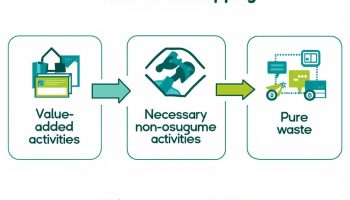
Understanding Lean Six Sigma DMAIC Project Examples
Lean Six Sigma DMAIC project examples highlight structured problem-solving approaches across industries, from reducing manufacturing defects to optimizing healthcare wait times. These examples show how the Define-Measure-Analyze-Improve-Control methodology creates a systematic framework for tackling operational inefficiencies and quality issues in organizational processes.
Business Impact of Implementing DMAIC Projects
Lean Six Sigma DMAIC project examples offer businesses practical frameworks to achieve measurable performance improvements with significant return on investment. Companies using these methodologies experience concrete benefits such as 52% defect reduction in manufacturing that saved $2.1M annually or 40% faster loan processing in financial services. These projects also boost customer satisfaction through shorter emergency room wait times and better call center resolution rates. The competitive advantages from DMAIC projects directly improve operational performance and financial results.
DMAIC project examples serve as valuable learning tools for your organization. By studying successful implementations, you’ll gain insights into how similar challenges were overcome in your industry. Each example demonstrates how the structured approach transforms complex problems into manageable improvement opportunities.
The power of DMAIC lies in its versatility. You can apply this methodology to virtually any process requiring improvement, whether you’re streamlining administrative workflows or optimizing production lines. Real-world examples show how organizations have customized the framework while maintaining the core principles of data-driven decision making.
When reviewing Lean Six Sigma DMAIC project examples, pay attention to the specific tools used at each phase. This reveals which analytical methods might work best for your unique situation. Successful projects often combine multiple techniques to gain comprehensive process understanding before implementing changes.
Organizations implementing Lean Six Sigma see an average return on investment of $3 to $10 for every dollar spent, highlighting its effectiveness in driving continuous improvement and operational excellence.
5 Lean Six Sigma DMAIC Project Examples: Boost Efficiency with Proven Strategies
In today’s competitive landscape, organizations across various sectors are continuously looking for ways to enhance efficiency and quality. Lean Six Sigma methodologies, particularly the DMAIC (Define, Measure, Analyze, Improve, Control) framework, have proven instrumental in driving process improvements. This section delves into five impactful Lean Six Sigma DMAIC project examples that highlight successful applications in manufacturing, healthcare, financial services, customer service, and supply chain management. Each example illustrates not only the challenges faced but also the structured approach taken to achieve significant results. By studying these cases, you can gain valuable insights and ideas for implementing similar improvements in your own organization.
“`html
1. Manufacturing: Reducing Assembly Line Defects
When implementing lean six sigma DMAIC project examples in manufacturing, you’ll find that defect reduction offers significant ROI. In this automotive parts assembly case, the team aimed to decrease defect rates by 40%. The Define phase mapped the current process and identified critical quality points where defects occurred most frequently. During Measure, they tracked defect types and rates over three months, establishing a clear baseline. The Analyze phase revealed the root cause: inconsistent torque application during assembly. For the Improve step, the team implemented an automated torque monitoring system to ensure proper specifications. The Control phase established daily quality checks and monthly post-implementation audits to maintain gains. This lean six sigma project delivered a 52% reduction in defects, exceeding the original goal and generating $2.1M in annual savings.
“`
2. Healthcare: Emergency Department Wait Time
Implementing Lean Six Sigma DMAIC project examples in healthcare settings can dramatically improve patient experiences. This emergency department project tackled excessive wait times using structured problem-solving. The team began by defining the project goal: reducing average wait times from 45 to 25 minutes. They documented current patient flow and identified key bottlenecks in the process.
During the Measure phase, they tracked wait times across different shifts and days to establish reliable baseline data. The Analysis revealed that the inefficient triage process was the primary contributor to delays.
To improve the situation, the team implemented:
- A rapid triage protocol that prioritized patients more effectively
- Digital queuing system to streamline patient management
- Reorganized staff scheduling based on peak demand periods
For the Control phase, they created an hourly monitoring dashboard that allowed real-time performance tracking. This ensured sustainability of the improvements and allowed for quick interventions when needed.
The outcome exceeded expectations with average wait times reduced to just 22 minutes, improving both patient satisfaction and emergency department efficiency.
Expert Insight: To enhance emergency department efficiency, utilize Lean Six Sigma’s DMAIC approach. Start by identifying bottlenecks through data analysis, implement rapid triage protocols, and use real-time monitoring dashboards. These strategies can significantly reduce wait times, improve patient satisfaction, and streamline operations.
3. Financial Services: Loan Processing Efficiency
Implementing lean six sigma DMAIC project examples in financial services can transform loan processing operations dramatically. For this project, the goal was to reduce loan processing time by 30%, addressing a common pain point in banking services.
The Define phase involved mapping the end-to-end loan approval workflow to understand every step from application submission to final approval. During the Measure phase, the team documented processing times for each step, creating baseline metrics to track improvements against.
In the Analyze phase, the team identified several redundant approval steps that added no value but significant time to the process. Data analysis revealed that document verification consumed 40% of the total processing time.
The Improve phase introduced two key changes:
- Automated document verification system using OCR technology
- Streamlined approval hierarchy with fewer handoffs
The Control phase established weekly processing time reports to maintain continuous improvement and prevent regression to old practices. The results exceeded expectations, with loan processing becoming 40% faster while reducing operational costs by 25%.
Expert Insight: To enhance loan processing efficiency, adopt Lean Six Sigma DMAIC principles by mapping workflows and identifying bottlenecks. Implement automation for document verification and streamline approval hierarchies to cut processing times. Establish ongoing metrics to sustain improvements, achieving faster processing and reduced operational costs.
4. Customer Service: Call Center Response Time
Implementing lean six sigma DMAIC project examples in call centers can transform customer service operations. For this project, the goal was to improve the first-call resolution rate by 25%. The Define phase involved documenting current call handling procedures and identifying pain points in the workflow. During the Measure phase, the team tracked resolution rates and call duration to establish a performance baseline.
The Analyze phase revealed significant knowledge gaps in the service team, with representatives struggling to access information quickly during calls. Root cause analysis showed that 65% of escalated calls resulted from information accessibility issues rather than complex problems.
The team implemented several improvements:
- Comprehensive knowledge base with intuitive search functionality
- Decision-support tools with guided troubleshooting workflows
- Targeted training program addressing common customer issues
- Redesigned call scripts for more efficient information gathering
Through continuous improvement monitoring and daily performance tracking, the project achieved an impressive 35% improvement in first-call resolution rate. This exceeded the initial goal and generated significant cost savings by reducing callback volume and increasing customer satisfaction scores.
Expert Insight: To enhance call center response times, focus on building a comprehensive knowledge base and implementing decision-support tools. Targeted training addressing common issues can empower representatives, leading to increased first-call resolution rates. Continuous monitoring and performance tracking will ensure sustainable improvements and boost customer satisfaction.
5. Supply Chain: Warehouse Picking Accuracy
In this lean six sigma DMAIC project example, a distribution center aimed to improve their warehouse operations. The project goal was to reduce picking errors by 50%, which would directly impact customer satisfaction and reduce costly returns processing.
During the Define phase, the team mapped the current picking process and categorized error types, finding that 68% of errors occurred with similar-looking products. In the Measure phase, they tracked error rates by product type and storage location, discovering that high-bay storage areas had 3x more errors than lower shelves.
The Analyze phase revealed confusing shelf layouts as the main cause, with similar products often stored adjacently. Data showed that pickers made most errors during the last hour of shifts due to fatigue. The team implemented several improvements:
- Color-coded shelf labels for product categories
- Relocated frequently confused items to separate zones
- Implemented barcode verification at pick stations
- Reorganized workloads to rotate pickers between zones
Continuous improvement measures in the Control phase included daily accuracy reports and weekly team reviews. After six months, picking accuracy improved by 62%, exceeding the original target and saving approximately $350,000 annually in return processing costs.
Expert Insight: To enhance warehouse picking accuracy, focus on optimizing shelf layouts and categorizing similar items to minimize confusion. Implementing barcode verification and rotating pickers can reduce errors, especially during high-traffic times. Regularly monitoring and reviewing accuracy metrics ensures continuous improvement and boosts customer satisfaction while cutting costs.
Lean Six Sigma DMAIC Project Examples
Lean Six Sigma DMAIC project examples demonstrate systematic problem-solving across diverse industries, from reducing assembly line defects in manufacturing to improving warehouse picking accuracy in supply chain operations. These structured improvement initiatives follow the Define-Measure-Analyze-Improve-Control methodology to identify root causes, implement targeted solutions, and maintain sustainable results.
Benefits for Businesses
For business and enterprise users, Lean Six Sigma DMAIC project examples provide a proven framework to tackle complex operational challenges while delivering measurable financial returns. Organizations implementing these methodologies consistently achieve impressive results, such as:
- 52% defect reduction in manufacturing that saved $2.1M annually
- 40% faster loan processing in financial services
- 62% improvement in warehouse picking accuracy
This demonstrates how systematic process improvement directly impacts both customer satisfaction and bottom-line performance.






